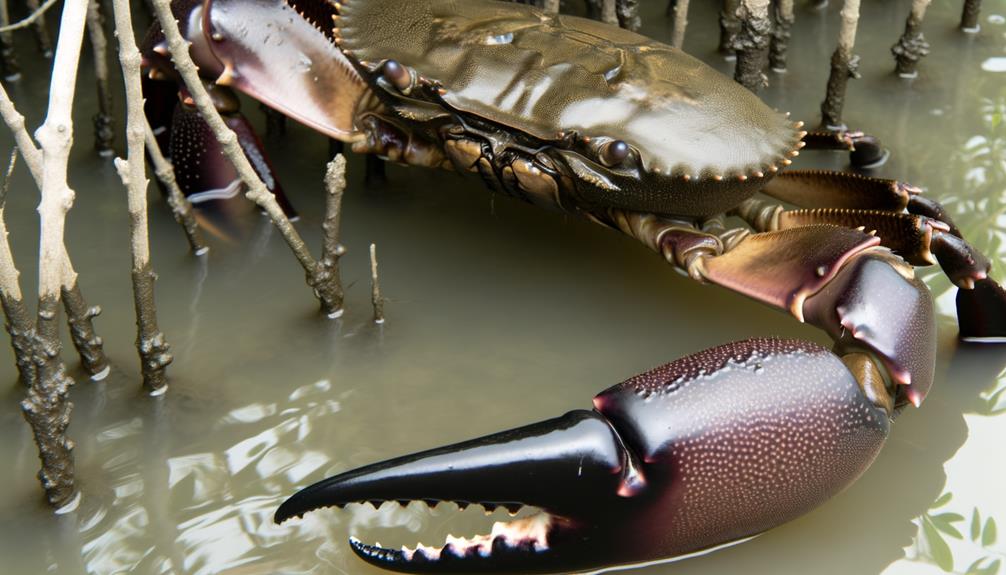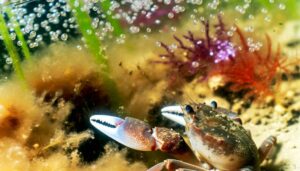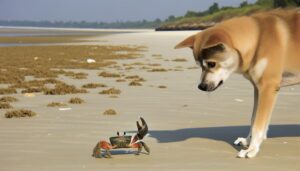How Can a Person Buy Snow Crab in South Florida Now?
Yes, a mud crab can break your finger. With its powerful claws, some species can generate over 60 psi of pressure, comparable to small mammals.
The claw's design, including serrated edges and robust musculature, allows it to exert tremendous force. Documented cases reveal severe lacerations and bone fractures from mud crab pinches.
Handling mud crabs without proper protection increases risk. Experts suggest using protective gloves and securing claws with rubber bands to minimize harm.
Discover more about their claw anatomy and real-life encounters that emphasize the need for respectful and careful interaction.

Key Takeaways
- Mud crabs can generate over 60 psi claw pressure, enough to break bones.
- Larger mud crabs possess stronger claws, increasing the risk of severe injuries.
- Documented cases exist of mud crabs causing severe lacerations and fractures.
- Serrated claw edges and robust musculature enhance their gripping and cutting power.
- Proper handling and protective measures are essential to avoid broken fingers.
Understanding Mud Crabs
Mud crabs, particularly those from the Scylla genus, are known for their powerful claws and robust exoskeleton. You'll find these crabs in estuarine environments, where they play a critical ecological role as both predator and prey.
Their adaptability to fluctuating salinity levels is remarkable, allowing them to thrive in diverse habitats. Mud crabs primarily feed on mollusks, small fish, and plant material, utilizing their strong mandibles for efficient foraging.
Research indicates their claws can exert significant force, a key factor in their survival and dominance. Understanding their behavior and physiological adaptations helps you appreciate their ecological impact and the potential risks they pose, such as the ability to inflict damage if not handled carefully.
Anatomy of Mud Crab Claws
The intricate structure of a mud crab's claws, featuring both a dactylus and propodus, allows for exceptional gripping strength and precision. The dactylus functions as the movable part, while the propodus acts as the fixed base. This design enables the mud crab to exert powerful forces. Additionally, these claws are equipped with serrated edges, enhancing their ability to hold and manipulate objects securely.
Here's a detailed look at the components:
| Component | Function | Description |
|---|---|---|
| Dactylus | Movable Part | Provides mobility to grip and cut |
| Propodus | Fixed Base | Acts as a stable anchor |
| Serrations | Enhanced Grip | Increases friction for secure holding |
Understanding these elements helps you appreciate how mud crabs achieve their remarkable dexterity and strength.
Claw Strength Analysis
Given the remarkable structure of their claws, it's important to quantify the actual strength these appendages can exert. Mud crabs possess a considerable biting force, which varies based on species and size.
Research indicates that some mud crab species can generate a claw pressure exceeding 60 pounds per square inch (psi). To give you a clearer picture:
- Claw Morphology: The design and robustness of the claw contribute significantly to its strength.
- Species Variation: Different mud crab species exhibit varying levels of claw force.
- Size Correlation: Larger crabs generally have stronger claws.
- Comparative Strength: Mud crabs' claw strength can rival that of some small mammals.
Understanding these factors helps in comprehending the potential risks and the true power behind a mud crab's pinch.
Real-Life Encounters
You've probably heard stories about the formidable pinch of mud crabs, but real-life encounters provide the most compelling evidence of their claw strength. Fishermen and coastal residents often recount incidents where mud crabs clamped down on their fingers, causing immediate, intense pain.
These accounts aren't just anecdotal; medical reports document cases of severe lacerations and even bone fractures caused by the crab's powerful claws. When a mud crab grips you, its pincers exert tremendous force, often leading to injuries that require professional medical treatment.
The force generated is sufficient to crush small bones, underscoring the need for caution when handling these crustaceans. Real-life experiences validate the potential risks posed by mud crabs, emphasizing the importance of respectful and careful interaction.
Expert Opinions
Several marine biologists and zoologists agree that the mud crab's claw strength can indeed pose a significant risk to human fingers. Their consensus is based on detailed studies and empirical data related to the biomechanics of the crab's pincers.
Here are key points supported by experts:
- Claw Force: Mud crabs exhibit a claw force exceeding 60 pounds per square inch, capable of causing fractures.
- Structural Analysis: The claw's serrated edges and robust musculature enhance its gripping power, making it a formidable natural tool.
- Injury Reports: Documented cases reveal that mud crab pinches have resulted in broken bones and severe lacerations.
- Behavioral Patterns: Aggressive defense mechanisms, especially when threatened, increase the likelihood of harmful encounters.
Understanding these aspects highlights the potential danger posed by mud crabs.
Comparing Crab Species
You should consider the differences in claw strength among various crab species to understand the risks they pose. Mud crabs exhibit notably stronger pincers compared to species like the blue crab, which impacts their potential danger to humans.
Additionally, examining their distinct habitats and behaviors will provide further insights into their interactions with people.
Claw Strength Differences
When comparing crab species, the claw strength of the mud crab stands out due to its powerful pincers capable of exerting significant pressure. Mud crabs can exert a force of up to 60 pounds per square inch (PSI), surpassing many other crustaceans. This makes them formidable in their environment and a potential hazard to human fingers.
Consider the following key points:
- Mud crab's PSI: Up to 60 PSI
- Blue crab's PSI: About 10 PSI
- Dungeness crab's PSI: Approximately 15 PSI
- Stone crab's PSI: Around 19 PSI
These differences highlight the substantial variance in claw strength among crab species. Understanding these metrics allows you to appreciate the mud crab's unique capabilities and the risks associated with handling them.
Habitat and Behavior
Mud crabs thrive in brackish waters of estuaries and mangroves, contrasting sharply with blue crabs that prefer the open waters of the Atlantic coast. This habitat divergence influences their behavior.
Mud crabs exhibit territoriality due to limited shelter in their constrained environments, making them more aggressive. Blue crabs, on the other hand, display more migratory behavior, moving between estuarine and marine habitats depending on life stages and seasons.
Observations suggest mud crabs' sedentary lifestyle promotes stronger, more robust claws for defense and foraging. Blue crabs, adapted to broader, open habitats, rely on speed and agility to evade predators.
Safety Precautions
Securing safety while handling mud crabs involves understanding their behavior and using appropriate protective equipment. Mud crabs possess strong claws capable of causing serious harm. To minimize risks, consider these precautions:
- Wear gloves: Sturdy gloves can offer protection against possible claw injuries.
- Utilize proper tools: Use crab tongs or nets to manage crabs, minimizing direct contact.
- Maintain a safe environment: Ensure the area is regulated and clear of distractions to stay focused.
- Comprehend behavior: Identify signs of aggression, such as lifted claws, which signal a readiness to pinch.
First Aid Tips
In the event of a claw injury, immediate first aid can prevent complications and speed up healing.
First, clean the wound thoroughly with soap and water to remove debris and reduce infection risk. Apply an antiseptic solution to disinfect the area.
If bleeding is present, apply direct pressure with a clean cloth until it stops. Use a sterile bandage to cover the wound, keeping it clean and dry.
Elevate the injured finger to reduce swelling and pain. Over-the-counter pain relievers like ibuprofen can help manage discomfort and inflammation.
Observe the wound for signs of infection, such as increased redness, swelling, or pus. If these symptoms appear, seek medical attention promptly to guarantee proper care and avoid further issues.
Myths and Facts
Contrary to popular belief, not all mud crab species possess the strength to break a human finger. You might've heard various exaggerated claims, but let's dissect the facts analytically.
- Species Variation: Different species have varying claw strengths. Not every mud crab can exert the pressure needed to cause a fracture.
- Claw Size: Larger claws generally mean stronger grip, but even among large crabs, the force can vary significantly.
- Scientific Evidence: Studies show that while some species like the giant mud crab (Scylla serrata) can generate substantial force, it's not universally true.
- Human Bone Strength: Your finger bones can withstand considerable pressure, making fractures from crab claws rare.
Understanding these factors helps demystify the myth and provides a clearer perspective.
Implications for Seafood Lovers
As a seafood lover, you must handle mud crabs with caution to minimize injury risks. Evidence shows that improper handling can lead to significant finger injuries due to their powerful claws.
Handling Mud Crabs Safely
Proper handling of mud crabs is crucial to prevent injury and guarantee a safe dining experience for seafood enthusiasts. You need to approach this task with caution and precision. By adhering to evidence-based practices, you'll minimize risks and enhance your culinary adventure.
- Use Protective Gloves: These reduce the likelihood of pinching injuries.
- Secure the Claws: Binding the claws with sturdy rubber bands can prevent accidental nips.
- Proper Grasp Technique: Hold the crab from the rear, avoiding the claws' reach.
- Maintain a Firm Grip: Consistent, gentle pressure ensures control without harming the crab.
These precautions are essential for ensuring your safety and the integrity of the crab, allowing you to enjoy your seafood without incident.
Risk of Injuries
Handling mud crabs improperly can lead to serious injuries, including painful pinches and potential fractures. Studies indicate that mud crabs possess powerful claws capable of exerting significant force. When threatened, these crabs instinctively clamp down, potentially causing soft tissue damage or even bone fractures in your fingers.
To minimize risk, always use appropriate tools like tongs or gloves when handling mud crabs. Evidence shows that direct contact increases the likelihood of injury. Veterinary reports and emergency room data confirm that mishandling mud crabs can result in severe lacerations and infections.
Taking proper precautions isn't just advisable but necessary. Remember, understanding and respecting the strength of these creatures ensures a safer experience for seafood enthusiasts.
Final Thoughts
Ultimately, while mud crabs possess powerful claws capable of inflicting serious injuries, the risk of a broken finger can be significantly reduced with cautious handling and proper technique.
By understanding the mechanics of their claws and the appropriate handling methods, you can safely interact with these fascinating creatures.
Consider these key points:
- Proper Handling: Use tools like tongs to avoid direct contact.
- Protective Gear: Wear thick gloves to shield your hands.
- Knowledge: Educate yourself about mud crab behavior to anticipate movements.
- Environment: Guarantee a controlled environment to reduce stress on the crab.
Conclusion
To wrap up, while mud crabs boast powerful claws capable of delivering a painful pinch, the likelihood of them breaking your finger is slim. Experts and real-life encounters suggest that caution is wise but fear is unnecessary.
Remember, the proof is in the pudding; by respecting these creatures and following first aid tips, you can enjoy your seafood adventures safely.
The myths might pinch, but the facts don't bite. Stay informed and savor responsibly.






